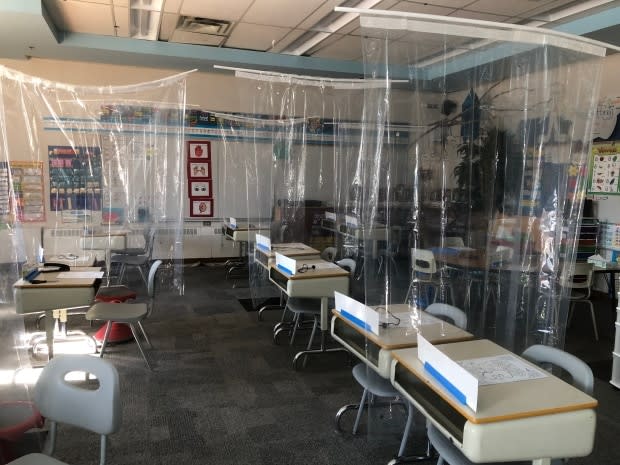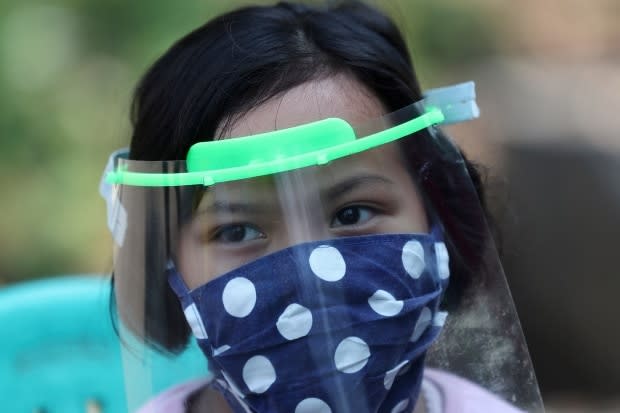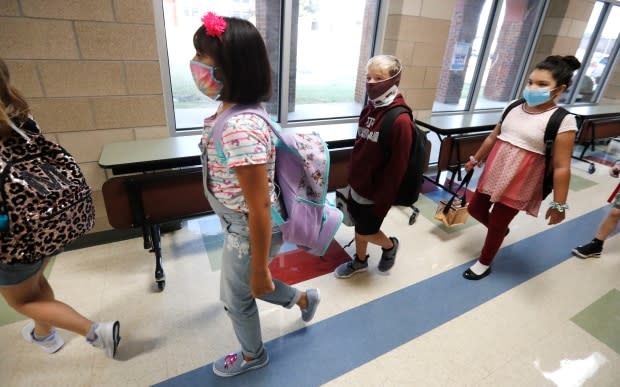How many masks should my child take to school? Your back-to-school mask questions answered

We're breaking down what you need to know about the pandemic. Send us your questions via email at COVID@cbc.ca, and we'll answer as many as we can. We'll publish a selection of answers on our website, and we're also putting some of your questions to the experts on the air during The National and on CBC News Network. So far, we've received more than 51,000 emails from all corners of the country.
Lunch bag? Check. Backpack? Check.
Masks? Check, check, check, check?
In most parts of Canada, students are heading back to class for the first time since the COVID-19 pandemic started, and parents have a lot of questions about how to properly prepare their kids to wear masks at school.
Dr. Susy Hota, medical director for infection prevention and control at the University Health Network in Toronto, said although masks aren't a fail-safe way of preventing the spread of COVID-19, it's not surprising parents have a lot of questions about their use.
"There's a lot of focus on masks because it feels like something tangible that we can do," she said. Parents have a lot more control over supplying masks for their kids than they do over how students will physically distance once they get to school, for example.
Here, Hota and other CBC News experts answer your questions on how to manage masks properly when school doors open.
How effective are masks at keeping schools safe from COVID?
Masks are an important piece of the picture, but infectious disease experts warn they're not enough on their own to manage outbreaks.
Speaking during an Ask the Doctors segment on The National, Dr. Lynora Saxinger, an infectious disease physician at the University of Alberta in Edmonton, said that "we would never want to rely on them over the other measures, like reducing contact numbers, increasing physical distance, washing your hands a lot and having good ventilation in the space."
Dr. Zain Chagla, an infectious disease physician at St. Joseph's Healthcare Hamilton, agreed.
"There is a hierarchy of infection-control measures in hospitals and in health-care settings and similarly in schools," he said. "Preventing and screening people for COVID-19 and keeping community rates low are probably at the biggest end of that pyramid."
Once these things are in place, masks work as source control for the virus, Hota told Dr. Brian Goldman, host of CBC Podcast The Dose.

"That means if you have a virus infection and you're wearing a mask, you stop the large droplets that have the virus within them from being released and infecting those around you, at least to some degree," she said.
"What we're learning with COVID-19 now is that you might actually have individual protection from those around you as well if you wear a mask in public. We didn't have that information in the earlier parts of the pandemic. But now we're seeing, as we put all the data together, that masks can be broadly helpful in reducing transmission from person to person outside of health-care settings and even just in the general community."
That said, different regions of Canada have made decisions on mask policy based on a number of factors, including the current level of transmission in the area. Elsewhere in the world, "there are school systems that have used them and school systems that haven't, and they've both had successful stories," Chagla said.
What about kids who have communication difficulties? Are there any studies on the impact of masks on small children and their speech development?
"Certainly, we know that kids learn language through lip reading," said Dr. Nisha Thampi, medical director of infection prevention and control at the Children's Hospital of Eastern Ontario in Ottawa. "And that's even for kids who are not hard of hearing. So it may be an amplified issue for kids who are hard of hearing."
Are face shields acceptable alternatives?
Compared to standard masks, not as much is known about how effective face shields are at preventing transmission of COVID-19.
"I wish there were recommendations around face shields as a safe alternative," Thampi told Goldman on The Dose.
Unfortunately, there isn't robust evidence in favour of using face shields on their own, without the use of a mask at the same time, she said. However, that could change.

"There is some evidence that's under peer review that suggests that they may be as effective. And there are certain jurisdictions in the U.S. that have gone to recommending face shields universally without face masks for their health-care workers with no clear evidence of infection transmission," Thampi said.
For now, we have to work with what's currently recommended by public health officials, she said.
However, other factors can be taken into consideration.
The U.S. Centers for Disease Control and Prevention says people who have hearing impairments or work with those who do may consider using a clear mask instead.
Hota said she hopes schools in areas with mask mandates will allow some room for interpretation based on individual needs.
"If there are kids who really can't tolerate the mask or keep taking it off, face shields might be an option," she said. "It would be a real pity if it was really rigid."
How many masks should kids leave home with each day?
There's no absolute number of masks that's going to be right for each child every day. "It really does depend on what a child is doing," Hota said.
"The way that we're wearing masks right now for sort of a general and broad public protection, you can wear your mask for a prolonged period of time. There actually isn't really an expiry in terms of how long you can wear your mask before you have to throw it out," she said.
Ditto for when fabric masks must be thrown in the wash.
Some provinces say they will provide two masks per day for each student, while others have said they will provide masks for students who don't have them.

The key is not to change the mask at a certain time of day, Hota said, but when the mask's condition requires it — admittedly a trickier call for a younger student to make.
"When your mouth gets moist or wet, if [the mask] feels like it's getting damaged in any way so that the integrity of it is not maintained, or if you think you've been sprayed with something or someone sneezed and you were right there, and it did its job protecting you, at that point you should be changing your mask."
Hota suggested kids have one backup mask available if a change is needed.
Where should my child put a mask when they take it off for food or drink, for example? Is it safe to wear one on a lanyard?
"I'm not in favour of using a lanyard or having it sort of attached to something that's going to be dragging around," Hota said.
Instead, she said, kids can do something as simple as putting a clean paper towel on their desk or lunch-room table and placing the mask there when it's not being worn. "Put it so that the outside surface of the mask is down and the inside, which is what touches your face, is kind of protected but open to the air."
Alternatively, the mask can go in a clean plastic or paper bag or a clean reusable container, or it can be hung by the ear loops from a hook on a cubby or the edge of a desk, Hota said.
When taking off a mask for just a short time, holding it like a basket from the ear loops is perfectly fine.
Hota said parents' "big message" to their children should be about the importance of cleaning their hands, either with hand sanitizer or soap and water, before and after handling their mask.
WATCH | Two infectious disease specialists on the role of masks in schools:
Students in our area are required to wear masks in the hall but not in classrooms. Won't taking the masks on and off constantly between in the classroom and hallways lead to touching the face over and over?
Hota said she finds this policy confusing given that prolonged exposure to one another in a classroom seems more risky than briefly passing others in the hall.
However, she said she expects authorities in these districts believe the more supervised environment of the classroom will allow teachers to monitor physical distancing better than in the hallways, which can get crowded when students move from class to class.
As for how masks should be handled between these transitions, again Hota stressed that cleaning hands before and after taking a mask on or off. If your child isn't required to wear a mask during class, they can use one of the ideas mentioned above for storing their mask until they head back into the school's common areas again.

What if my child refuses to wear one?
"It's a real challenge," Hota said. "I have a five-year-old, for example, and I've been working on this all summer long, but it's still not easy. There are some youngsters who don't really like the way that things feel on their face, for example."
Seeing older children wear their masks could help persuade reluctant youngsters to wear theirs, as could giving kids a choice about a mask's style and patterns, or setting up a crafty activity to personalize them.
"My message to everyone has been even if it's not mandatory, it doesn't mean you can't try," Hota said. "I think we should all be trying very hard to get our kids used to this."


